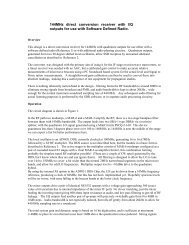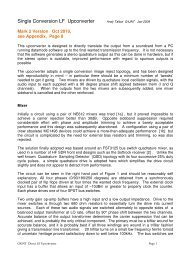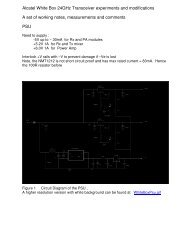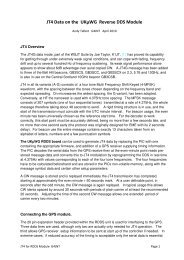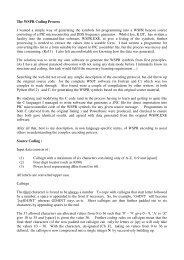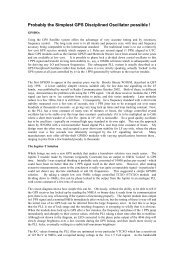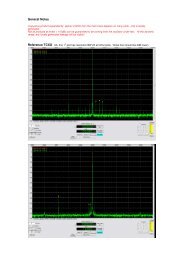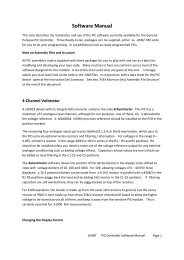50-75MHz Bandpass filter with some interesting ... - G4JNT
50-75MHz Bandpass filter with some interesting ... - G4JNT
50-75MHz Bandpass filter with some interesting ... - G4JNT
Create successful ePaper yourself
Turn your PDF publications into a flip-book with our unique Google optimized e-Paper software.
But then, I started wondering:<br />
In any bandpass <strong>filter</strong> consisting of coupled resonantors, real zeros (sharp nulls) can be added by<br />
cross-coupling non-adjacent resonators, and this is often done to improve the cutoff and sharpen<br />
the ilter edge response.. Low and high pass elliptic <strong>filter</strong>s generate real zeros for deep nulls in the<br />
stopband by adding resonating C or L components to series or shunt elements.<br />
My recollection from a dark past suggested that for bandpass deigns, these zeros always came in<br />
pairs, spaced either side of the passband.<br />
So, as an experiment, I added a few pF between stages 2 and 4 to see what happened, and analysed<br />
the result. Rather satisfactorily, a value of 1.5pF gave a null pretty close to 40MHz, and the<br />
rejection in this region was improved by at least another 10dB – just what was wanted. The ripple<br />
was slightly worse, but I can live <strong>with</strong> that – ultimately software can correct the amplitude<br />
response.<br />
The plot of the <strong>filter</strong> response is shown below.<br />
A very sucessful outcome from just idly playing around <strong>with</strong> a circuit analysis package!<br />
But where is the other zero that should be there, above the passband Searching all over the<br />
frequency response there is nothing!<br />
I can only assume that since a top-capacitor-coupled bandpass design is not truly symmetrical – as<br />
is obvious from the significantly lower stopband rejection above the centre frequency than below it<br />
- presumably the symmetrical argument disappears.<br />
But it would be nice to know why there is only the one real zero.<br />
(Incidently, I did try a feedback inductor instead of a capacitor, but all that did is destroy the<br />
passband response)<br />
… now to build a prototype.



